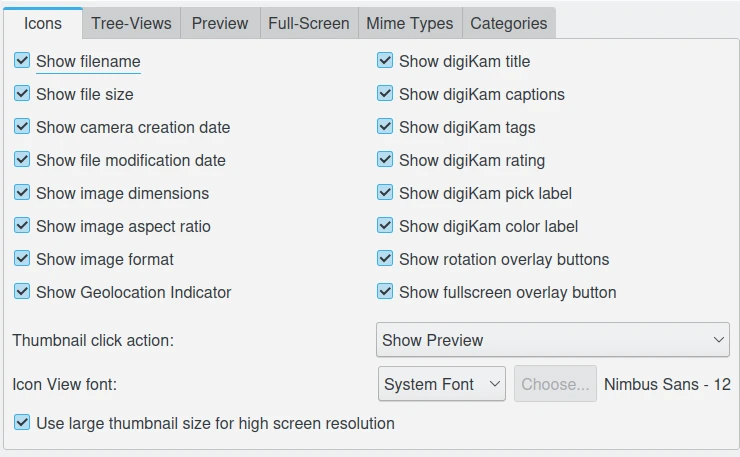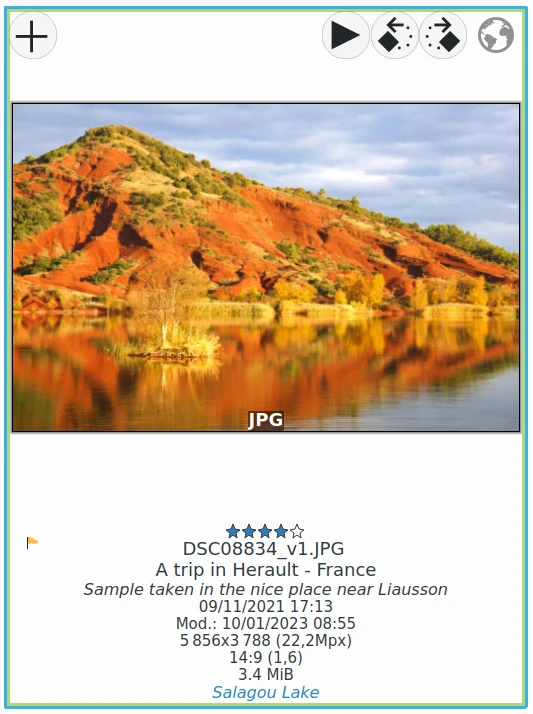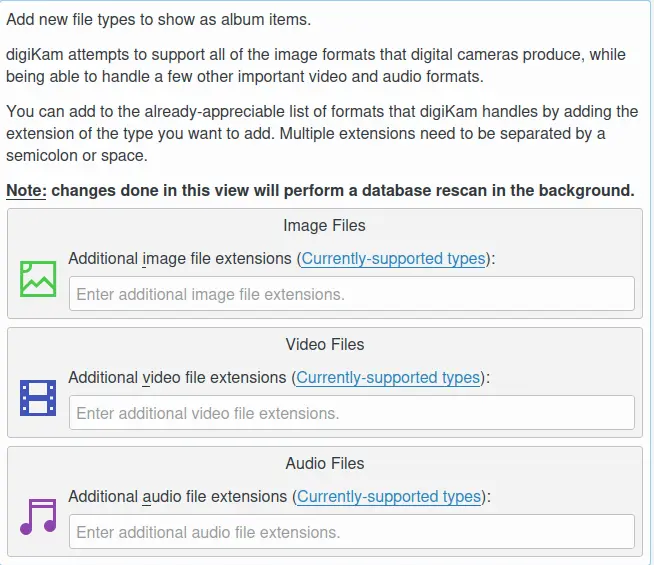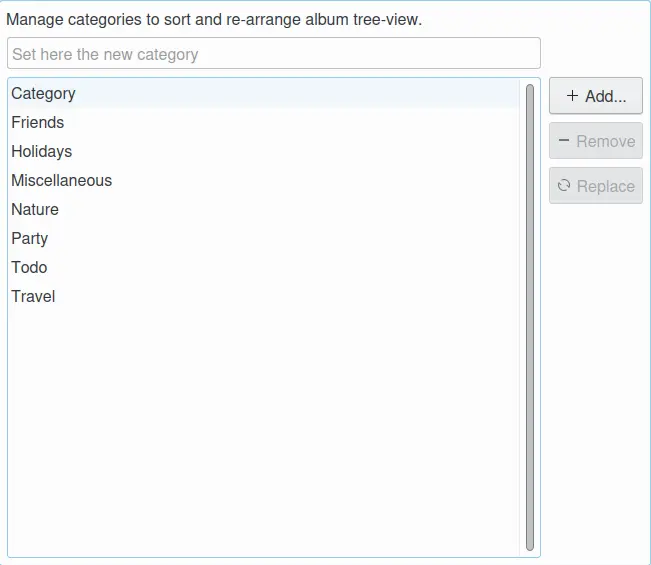Views Settings¶
The Views options for digiKam are set from . With this settings page, you can customize settings for digiKam Views, grouped into the following categories: Icons, Tree-Views, Preview, Full-Screen, Mime Types, and Categories.
Configuração dos Ícones¶

A Página de Configuração da Área de Ícones do digiKam¶
The first series of settings on the left side of this view allow you to select the technical information shown below the icon thumbnail, such as filename, file size, creation date, image dimensions, and aspect ratio.
The Show file modification date option shows the file modification date only if it’s different from the creation date. This function is useful to quickly identify which items have been modified.
A opção para Mostrar o indicador de geo-localização mostra um ícone sobre a miniatura da imagem, caso a mesma tenha dados de geo-localização.
The options on the right side allow you to customize other properties to show over and below the icon thumbnail, such as Image Format, Title, Caption, Labels, and the Rating.
The Show rotation overlay buttons option shows overlay buttons over the image thumbnail to be able to rotate an image left or right.
A opção para Mostrar o botão sobreposto de ecrã completo mostra um botão sobreposto sobre a miniatura da imagem para a poder abrir a ocupar o ecrã completo.
É dado em baixo um exemplo de um item na área de ícones:

Um Exemplo de Item na Área de Ícones com a Opção Usar um Tamanho de Miniaturas Grande¶
Dica
For technical and design reasons, the Icon-View only displays a minimal set of information under thumbnails. However, digiKam offers a practical workaround, the Table-View, where thumbnails are organized in rows, and columns can be fully customized to show any metadata stored in the digiKam database
A opção da Acção ao carregar na miniatura permite escolher o que deveria acontecer quando carregasse numa miniatura. Estão disponíveis quatro opções:
Mostrar uma antevisão para mostrar o item no Modo de Antevisão F3.
Iniciar o editor de imagens para abrir a imagem numa janela separada do Editor de Imagens F4.
Show on Light Table to open the image in a separate Light Table window.
Abrir com a Aplicação Predefinida para abrir o item na aplicação predefinida do ambiente de trabalho.
The Icon View font option allows you to select the font used to display text under icon-view items.
The Use large thumbnail size for high screen resolution option renders the icon-view items with a large thumbnail size, which can be useful if you are using a 4K monitor. By default this option is turned off and the maximum thumbnail size is limited to 256 x 256 pixels. When this option is enabled, the thumbnail size can be extended to 512 x 512 pixels. This option will store more data in the thumbnail database and will use more system memory. digiKam needs to be restarted for the option to take effect and the Rebuild Thumbnails option from the Maintenance Tools dialog needs to be executed to reprocess the thumbnails for all collections.
Configuração da Árvore¶
These settings allow you to customize the tree views of the Left and Right Sidebar.
The Tree View icon size option configures the size in pixels of the Tree View icons in digiKam’s sidebars. Use larger values for HiDPI screens.
A opção Tamanho dos ícones da árvore de Pessoas configura o tamanho em pixels dos ícones da árvore na barra lateral de Pessoas do digiKam.
A opção do Tipo de letra da árvore configura o tipo de letra usado para mostrar o texto nas hierarquias de álbuns encadeadas.
A opção Mostrar a Quantidade de Itens nas Árvores irá mostrar o número de itens dentro de uma pasta ou atribuídas a uma marca atrás do nome do álbum/marca. A quantidade apresentada depende se as sub-pastas/marcas estão expandidas ou não e das opções e do menu principal.

A Página de Configuração da Árvore do digiKam¶
Configuração da Antevisão¶
Instead of opening the image in the editor, the digiKam preview mode F3 will show the image within the Image Area of the main window. The advantage of the main window preview is that it is faster than opening the image editor and that the icons of the other images remain visible so that you are able to review the list of current images quickly. Depending on your computer features, you can customize the best way to load images into the preview. Raw files can be processed differently, as this kind of container can require long computation.

A Página de Configuração da Antevisão do digiKam¶
The option Preview shows embedded view if available will try to open a small version of the photograph embedded in the file. Small embedded images can be found in all RAW files and in all files that support IPTC or XMP like PNG, JPEG, TIFF, JPEG2000, PGF. If an embedded preview cannot be found, some image decoders (JPEG, JPEG2000, and PGF, WebP) are able to create a reduced version of the photograph by themselves which is still faster than using the whole image. Depending on the size of the image, the size of the embedded preview and the size available for the preview on your screen the effect of this option may or may not be evident.
The option Preview shows the full image will always use the full image data for the preview regardless of whether there is a reduced version embedded in the file or not. This can result in a higher quality preview but is usually slower.
If the last option is checked, the drop-down field to the right of Raw images is accessible. It offers three options: with Automatic selected, the Libraw decoder will decode the RAW data automatically without any adjustments from the user. This sometimes leads to weird results. The algorithm also takes screen resolution and CPU speed into account to try to balance speed and rendering quality. Embedded preview will try to use the (JPEG) preview embedded in RAW files. Raw data in half size will show unprocessed RAW data in reduced size.
The option Preview image is converted to 8 bits for a faster viewing must be unchecked if you do not want to convert a 16-bit preview image to 8 bits. This will improve performance.
The option Preview image is always scaled to fit to window will enlarge the image to always fit the free space available on the canvas. More precisely, fit to window means that it would downscale larger images to fit, as well as upscale smaller images to fit. Shrinking an image is usually not a problem, but enlarging a small image can introduce artifacts. If you don’t want your small images enlarged, leave this option off.
The option Preview image use Anti-aliasing scale up will blur details in an image when you zoom-in to the pixel level. Disable this option to show pixel artifacts when zoomed in.
The option Show icons and text over preview will show elements for rotation, face tags, full screen mode, etc. in the top left corner of the image preview and text indicating which data the preview is showing in the top right corner.
Configuração do Ecrã Completo¶
As opções nesta página aplicam-se só ao modo de Ecrã Completo, o qual consegue aceder com o botão de Ecrã Completo na barra de ferramentas ou através da opção Ctrl-Shift-F no menu principal ou no menu de contexto. Não se aplica ao modo de Ecrã Completo a que acede se carregar no ícone “Mostrar no Ecrã Completo” sobre uma miniatura ou na antevisão.

A Página de Configuração do Ecrã Completo do digiKam¶
If the Hide toolbars option is activated, the only way to leave the Full Screen Mode is the context menu, or the keyboard shortcut Ctrl-Shift-F. You can work on the images also by choosing functions from the context menu of an icon or preview.
Configuração dos Tipos MIME¶
digiKam can understand lots of different image file types as well as some video and audio formats. To control which types of files digiKam will try to display you can add or remove file extensions from these lists. digiKam ignores any files that are in the digiKam Album folders that do not match these extensions.
Nota
A configuração predefinida poderá ser reposta facilmente se carregar nos botões de actualização, à direita de cada categoria.

A Página de Configuração de Tipos MIME do digiKam¶
Poderá adicionar as extensões dos ficheiros de imagens (incluindo os ficheiros RAW) a apresentar na área do Álbum. Basta escrever xyz abc para mostrar os ficheiros com as extensões xyz e abc na área do seu álbum. Também poderá remover formatos de ficheiros que são apresentados por omissão, colocando um sinal de menos antes da extensão: p.ex., -gif iria remover todos os ficheiros GIF do seu álbum e todos os vestígios dos mesmos na sua base de dados. Eles não serão apagados, simplesmente ficam invisíveis no digiKam.
Aviso
Remover os ficheiros da base de dados significa que perde todos as suas marcas e classificações.
Configuração das Categorias do Álbum¶
In the Album View you can choose from to have the Albums in the Album Tree of the Left Sidebar sorted by category. Here you can manage these categories by using the Add, Remove, and Replace button. Use the Replace button to rename a category. To assign categories to an Album you must use the Album Properties dialog.

A Página de Configuração das Categorias dos Álbuns no digiKam¶